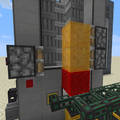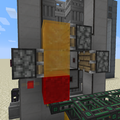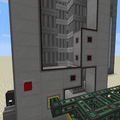Fission Reactor: Difference between revisions
mNo edit summary |
mNo edit summary |
||
| Line 146: | Line 146: | ||
* For good measure, even if a tube or pipe just crosses a chunk, keep it loaded. | * For good measure, even if a tube or pipe just crosses a chunk, keep it loaded. | ||
* Always start with low burn rates (the default 0.1 mB/t is good!) and increase it in small steps. | * Always start with low burn rates (the default 0.1 mB/t is good!) and increase it in small steps. | ||
* Use conservative on burn rates. Even the biggest reactor backed by several boilers and turbines cannot run at its maximum theoretical burn rate. | |||
=== Circuit Breaker === | === Circuit Breaker === | ||
| Line 188: | Line 188: | ||
This won't prevent someone from restarting the reactor before the emergency coolant tank is full though. Implementing this is left as an exercise to the reader. | This won't prevent someone from restarting the reactor before the emergency coolant tank is full though. Implementing this is left as an exercise to the reader. | ||
=== Avoiding bottlenecks === | === Troubleshooting and Avoiding bottlenecks === | ||
Bottlenecks in the cooling chain and power drain are what limits the actual burn rate of a reactor. | |||
An [[Industrial Turbine]] must be fitted with enough [[Saturating Condenser]]s to allow a sufficient flow of water back from the turbine to the reactor or [[Thermoelectric Boiler]]. 1 mB/t of [[Fissile fuel]] burnt requires 20000 mB/t of steam and water (this applies to water and sodium cooled reactors). Given that a condenser provides 64000 mB/t of water, this translates to 1 condenser for 3.2 mB/t of [[Fissile Fuel]] burnt. | |||
TBC... | |||
== Radiation and nuclear waste handling == | == Radiation and nuclear waste handling == | ||
Revision as of 17:10, 23 July 2020
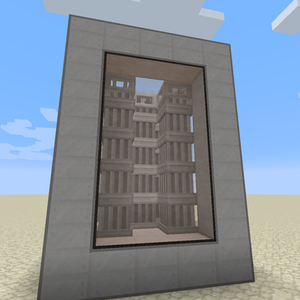
This page is a work in progress! Many essential things are missing.
The Fission Reactor is a multiblock structure that allows for variable input rates of Fissile Fuel. The reactor uses either Sodium or water as a coolant. Power is generated by converting the generated heat into power in an Industrial Turbine. With water cooled reactors, this is done by directly piping steam into an Industrial Turbine. Sodium cooled reactors use a Thermoelectric Boiler as a heat-exchanger to cool down the Superheated sodium and heat up water into Steam.
Contents
Construction
- The structure must be a cuboid of minimum size 3x4x3 (along X, Y and Z), up to 18x18x18.
- The edges of the outer shell must be made of Fission Reactor Casing
- The faces of the outer shell can be either Fission Reactor Casing, Reactor Glass, Fission Reactor Port or Fission Reactor Logic Adapter
- The interior of the cube can be either air or fission control rods:
- A control rod is formed by a 1x1 block wide column made of 1 to 15 Fission Fuel Assembly and a single Control Assembly at the top
- Control rods must not touch each other. Maximum control rod density can be achieved by placing them in a checkerboard pattern.
Some example control rod setups as seen from the top ( is for Fission Reactor Casing or Reactor Glass, R is for a control rod):
CCCCC CCCCC
CCC C C CR RC
CRC CR RC C R C
CCC C C CR RC
CCCCC CCCCC
A fission reactor requires at least 4 Fission Reactor Ports:
- One coolant input
- One coolant output
- One Fissile Fuel input
- One waste output
Output ports must be configured to the proper output type by crouching and right-clicking them with a Configurator.
Reactor GUI
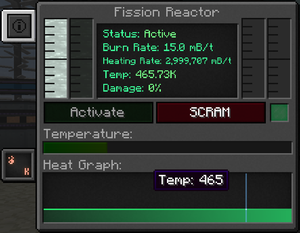
The reactor's GUI shows it's status, burn rate, heating rate, temperature and structural damage (health).
Status
The reactor's running status, either active or disabled.
To activate the reactor, either click the green activation button, or send a redstone signal to a Fission Reactor Logic Adapter configured in activation mode (just right click the Fission Reactor Logic Adapter block to configure it).
The reactor stops when a player clicks the red SCRAM button or if a redstone signal on a logic adapter goes from 1 to 0.
Burn Rate
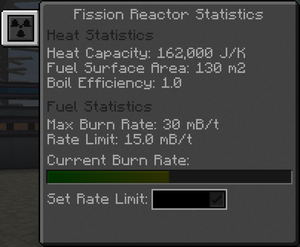
The burn rate is the rate at which the reactor will burn Fissile Fuel. For a newly formed reactor, it is automatically set to 0.1 mB/t. It can be changed in the reactor's statistics tab.
The theoretical maximum burn rate is 1 mB/t per [[Fission Fuel Assembly in the reactor, but the effective maximum burn rate depends on a number of factors (see #Safe operation).
Heating Rate
The heating rate represents how much coolant is heated up per tick. The actual value depends on the burn rate. For a burn rate of one 1 mB/t, the heating rate is:
- 20000 mB/t for a water cooled reactor
- 200000 mB/t for a sodium cooled reactor
For safe operation, the external cooling setup must be able to handle that much heated coolant per tick. See Throughput and #Safe Operation.
Temperature
The core's temperature: green OK, yellow: danger zone, red: imminent meltdown.
TODO: add actual figures.
Damage
This indicates the actual structural damage of the reactor. When a reactor reaches critical temperature, it will start taking damage and this value will go up. The damage value of a reactor that has overheated but been stopped on time to prevent a meltdown will slowly go down on its own, no player intervention is needed.
TODO: need more tech details: how fast is damage recovery? does it recover if running in the danger zone (yellow heat value), etc.
Cooling and power production
Cooling a fission rector and converting the generated heat into power can be done in two ways: water cooling and sodium based cooling.
Important:
- the Industrial Turbine must have Saturating Condensers in order to be able to condense steam into water and pipe that water back to the reactor or boiler. The max water output from a turbine can be seen in its statistics tab. The actual value is 64000 mB of water per condenser. Condensers must be placed at the same level as the Electromagnetic Coils or above them (a single coil is sufficient for 4 blades, so this leaves plenty of room at the same level).
- the turbine has an internal energy buffer that will slowly (more or less) fill up. Once full, it will only consume as much steam as needed to provide power to external consumers. As a result, its steam tank will start to fill up if the reactor generates steam faster than the turbine consumes it, less coolant will flow back to the reactor, resulting in less and less fresh coolant in the reactor's coolant tank. The reactor will start to eat up, until meltdown. See the #Safe operation section for more details and ways around this.
This applies to all cooling solutions.
Water based cooling
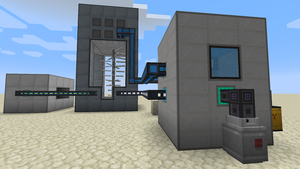
Water based cooling is sufficient for small setups, i.e. reactors with less than 20 Fission Fuel Assembly and a max burn rate of 20 mB/t. Beyond that, it gets hard to keep the temperature of the reactor core within acceptable parameters.
Setup
- pipe water into a Fission Rector Port configured as input only
- Connect a Fission Reactor Port configured as coolant output to the steam input valve of an Industrial Turbine.
- Connect a Mechanical Pipe from one of the Industrial Turbine's vents back to the coolant input of the reactor (or back to the same same mechanical pipe network from the first step).
A water cooled reactor has a heat rate of 20000 mB of water for 1 mB of Fissile Fuel burnt.
For your reactor to run smoothly, the pipes and tubes connecting the reactor and turbine must have a Throughput at least equal to the heat rate of the reactor. See also #Safe operation. As mentioned above, the power drain must be higher than what the turbine actually produces (use an Induction Matrix between the turbine and the rest of the power consumers. Monitor the matrix's fill ratio regularly.
Sample build
The picture to the right shows a minimal fission reactor setup. From left to right: Induction Matrix, Industrial Turbine, Fission Reactor. The reactor has a single Fission Fuel Assembly. It takes Fissile Fuel from its front input port, Nuclear Waste is output to the right to a Nuclear Waste Barrel. In the back behind the reactor, there are two Electric Pumps feeding the coolant loop with fresh water if need be. The Industrial Turbine is a minimal 5x9x5. This setup generates 71.4 kJ/t when burning Fissile Fuel at its maximum of 1 mB/t. That's roughly 2.5 times less power than a Gas-Burning Generator burning Ethylene.
Sodium based cooling
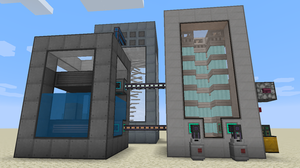
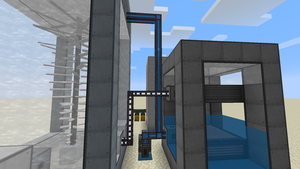
For larger reactors, with a burn rate higher than 20 mB/t, Sodium is a much more efficient coolant and allows very high burn rates at lower core temperatures (but not more energy per mB of fuel burnt). Sodium based cooling requires a Thermoelectric Boiler as an intermediate heat-exchanger to cool down the Superheated sodium from the reactor and heat up water into Steam.
The Thermoelectric Boiler has been updated in Makanism v10 to allow it to use heated coolant as a heat source. The Boiler Valves can be configured with a Configurator (crouch + right click) to make them input only, output steam or output coolant.
A sodium cooled reactor has a heat rate of 200000 mB of Sodium for 1 mB of Fissile Fuel burnt. The boil rate of the boiler will be 20000 mB of water for 1 mB of Fissile Fuel burnt (the water throughput is the same as for a water cooled reactor).
For your reactor to run smoothly, the tubes connecting the reactor and boiler must have a Throughput at least equal to the heat rate of the reactor, and the tubes and pipes running between the boiler and turbine must match the boiler's boil rate. See also #Safe operation.
Setup
Setup a Thermoelectric Boiler + Industrial Turbine as described on the boiler page with the exception that in step 7, you will need two Boiler valves on a steam catch or steam cavity layer, one for steam output, the other for coolant output.
It is important to build the boiler with water cavity layers (step 3c of the boiler's setup) in order to have a decent enough water + heated coolant storage capacity.
Next, connect the the boiler steam output (at or above the steam catch layer) to the turbine steam input, and pipe water back from one of the turbine's vents to one of the boiler's inputs at the heater or water cavity layers.
Setup fully some fully upgraded Electric Pumps (1 KJ/t for 1000 mB of water per tick) to inject fresh water in the water-steam loop. It is necessary to keep them running in order to keep the boiler's water tank full when running at high heat rates (compared to what the boiler can support). How many pumps are required is left to the reader to experiment with (see #Safe Operation).
Finally, connect the reactor's heated coolant output to one of the boiler's inputs at the heater or water cavity layers, and the boiler's coolant output to one of the reactor's inputs. While the boiler's valves must be placed in the proper layers. the placement of the reactor's ports does not matter.
Sample build
The picture to the right shows a 5x9x5 sodium cooled fission reactor, backed by a fairly small 5x7x5 Thermoelectric Boiler and a 7x13x7 turbine with 18 blades. It produces 3.85 MJ/t (1.54 MFE/t, 385.63 kEU/t) at peak burn rate (30 mB/t). Note that this same turbine could work with a reactor twice that size, but the boiler would need to be extended. On the right side of the reactor there is a crude, yet effective breaker-switch system (see #Safe Operation).
The second picture shows the boiler and turbine piping as well as a single pump (which is not enough for this configuration).
Safe operation
The worst thing that can happen is a core meltdown, which in Mekanism results in a big explosion. Big. Really big. Followed by lethal radiations over a 5 chunks radius (that's 80 blocks) that will last for several in-game weeks.
A few rules of thumb:
- In order to avoid chunk loading related glitches, do not build a fission reactor, Thermoelectric Boiler or Industrial Turbine on a chunk boundary.
- Keep all chunks involved in fission power generation and waste recycling loaded (use an Anchor Upgrade in Teleporters or Quantum Entangloporters).
- For good measure, even if a tube or pipe just crosses a chunk, keep it loaded.
- Always start with low burn rates (the default 0.1 mB/t is good!) and increase it in small steps.
- Use conservative on burn rates. Even the biggest reactor backed by several boilers and turbines cannot run at its maximum theoretical burn rate.
Circuit Breaker
Every reactor should have a circuit breaker that will, in many cases, prevent accidental meltdown or waste leaks.
Any form of RS-latch can be used for this purpose, with the SET signal wired to reactor critical conditions and Q output to reactor activation.
The pictures below show a crude yet effective circuit breaker setup. Despite its rudimentary look, it is impervious to destruction by water or lava spills.
-
Switched on
-
Tripped
-
Logic adapter layout
All pistons are regular, NON-sticky pistons. The two honey blocks can be replaced by slime blocks, which ever is the easiest to acquire.
The rightmost picture shows the Fission Reactor Logic Adapter layout. The two on the top right are set to signal on excessive heat and waste tank full. The bottom center one is set on "activation".
When building it, the reactor's burn rate should be set to 0, so that when the redstone block is placed, the reactor will activate but not burn anything.
A button should be placed on the back of the leftmost piston to switch the circuit breaker back on whenever it gets tripped.
The reactor should never be activated if the circuit breaker is in the tripped position: even with an adapter set to "activation" nothing will prevent the player from forcibly activating the reactor from its GUI; from this point any critical condition will not trip an already tripped circuit breaker and cause a meltdown. Failing to follow this rule may result in a false feeling of safety. In order to prevent this, note the presence of an Industrial Alarm on the bottom left. It should be triggered by the restone block when the circuit breaker is tripped. Its main use is to annoy player until he turns the breaker back on.
Here is the basic procedure to follow when the circuit breaker is tripped by a critical condition:
- Set the reactor burn rate to 0
- Switch the circuit breaker back on (this will activate the reactor but this is safe since it won't burn fuel). The annoying alarm is now gone.
- Fix whatever caused the problem
DISCLAIMER: A circuit breaker will not help in all situations. In case of reactor overheating with a large reactor and burn rate and critical coolant shortage, the temperature will have reached over 1400K before tripping the breaker. Without a quick injection of new coolant, the reactor will not cool down quickly enough and will keep taking structural damage until the unthinkable happens.
A more foolproof solution would involve building an emergency coolant tank and connect it to the reactor via a redstone-activated tube. Then when receiving a critical condition signal from the reactor:
- send a on/off pulse to an activation adapter (on: the reactor registers that it is redstone activated, off: switches it off)
- activate the input from the emergency tank (it doesn't need to be latched)
- trigger an alarm
This won't prevent someone from restarting the reactor before the emergency coolant tank is full though. Implementing this is left as an exercise to the reader.
Troubleshooting and Avoiding bottlenecks
Bottlenecks in the cooling chain and power drain are what limits the actual burn rate of a reactor.
An Industrial Turbine must be fitted with enough Saturating Condensers to allow a sufficient flow of water back from the turbine to the reactor or Thermoelectric Boiler. 1 mB/t of Fissile fuel burnt requires 20000 mB/t of steam and water (this applies to water and sodium cooled reactors). Given that a condenser provides 64000 mB/t of water, this translates to 1 condenser for 3.2 mB/t of Fissile Fuel burnt.
TBC...
Radiation and nuclear waste handling
As a byproduct of burning Fissile Fuel, fission reactors produce Nuclear Waste which can be converted in either Polonium Pellet or Plutonium Pellet. Both conversion paths produce Spent Nuclear Waste as a byproduct (at a ratio of 10:1), which must be stored in Radioactive Waste Barrels. Nuclear Waste or Spent Nuclear Waste can be piped into a Nuclear Waste Barrel from its top or bottom side with a Pressurized Tube.
- Nuclear Waste is radioactive.
- All products and intermediate products of converting Uranium Ore to Fissile Fuel are not radioactive, i.e. safe to handle.
- Intermediate products and byproducts of recycling Nuclear Waste are radioactive: Polonium, Plutonium and Spent Nuclear Waste.
- Plutonium Pellets and Polonium Pellets are not radioactive.
Radiation can leak into the environment for the following reasons:
- Fission reactor overheating leading to a core meltdown (actually blowing up).
- Fission reactor running with its waste tank full.
- Breaking any block containing radioactive materials. Most notably Pressurized Tubes and Radioactive Waste Barrels, but also any machine (like a Pressurized Reaction Chamber containing radioactive materials. These can still be broken safely if they are somehow drained of their radioactive contents beforehand.
Quantum Entangloporters cannot handle radioactive materials. As a result, it is not possible to make Polonium Pellets with a reactor in the nether (since the Solar Neutron Activator, which is required to produce Polonium from Nuclear Waste needs direct sunlight) or have a reactor in the overworld and store waste in the nether.
Nuclear Waste Barrels
TODO: move this to its own page
Waste Barrels are used to store (or as buffer for) Nuclear Waste and Spent Nuclear Waste. They delete their contents at a rate of 1 mB per minute.
The player can check the storage status of Nuclear Waste Barrels by crouching and right-clicking it with an empty hand. Green radiation particles start to appear as a barrel fills up (these are just a rough visual indicator of a barrel's fill ratio, not actual radiations).
Waste barrels cannot be moved by any means (pistons, cardboard box, etc.). Also because barrels containing any radioactive waste cannot be broken safely, the only way to safely move a non empty barrel it transfer its contents to another barrel before breaking it. This can be done by connecting a Pressurized Tube to its top or bottom side in pull mode.
Even if Waste Barrels are blast resistant, but pressurized tubes carrying waste to them are not. As a rule of thumb, do not allow creepers wandering around a fission reactor or waste transformation or disposal units.
Tips
- For any given reactor burn rate, the more turbine blades, the more energy is produced per mB of Fissile Fuel. As a result, the bigger the turbine the better. Also it is best to max out the rotor height and make trade-offs on the vents/condensers count. With a slightly shorter rotor, one could add more condensers and achieve higher burn rates and total power produced, but at a higher cost in terms of power produced per mB of Fissile Fuel burnt.
- Experiment in a creative world! There, you can experiment with the console commands (the last one is just in case things go wrong, but don't be a chicken and abuse it!):
/mek build fission /mek build remove /mek radiation removeAll
- Whenever Polonium Pellets are not needed anymore, keep recycling Nuclear Waste into Plutonium -> Plutonium Pellets -> Reprocessed Fissile Fragments -> Fissile Fuel. In addition to decreasing the uranium ore consumption, this divides the storage capacity needs of nuclear waste by a factor of 10.


